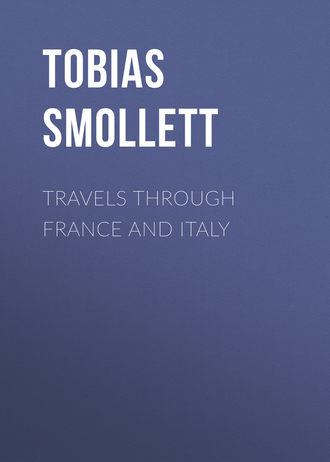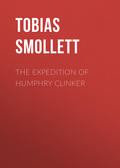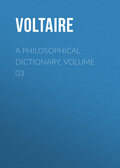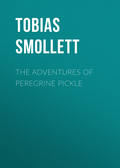
Tobias Smollett
Travels through France and Italy
LETTER XXVIII
NICE, February 5, 1765.
DEAR SIR,—Your entertaining letter of the fifth of last month, was a very charitable and a very agreeable donation: but your suspicion is groundless. I assure you, upon my honour, I have no share whatever in any of the disputes which agitate the public: nor do I know any thing of your political transactions, except what I casually see in one of your newspapers, with the perusal of which I am sometimes favoured by our consul at Villefranche. You insist upon my being more particular in my remarks on what I saw at Florence, and I shall obey the injunction. The famous gallery which contains the antiquities, is the third story of a noble stone-edifice, built in the form of the Greek Pi, the upper part fronting the river Arno, and one of the legs adjoining to the ducal-palace, where the courts of justice are held. As the house of Medici had for some centuries resided in the palace of Pitti, situated on the other side of the river, a full mile from these tribunals, the architect Vasari, who planned the new edifice, at the same time contrived a corridore, or covered passage, extending from the palace of Pitti along one of the bridges, to the gallery of curiosities, through which the grand-duke passed unseen, when he was disposed either to amuse himself with his antiquities, or to assist at his courts of judicature: but there is nothing very extraordinary either in the contrivance or execution of this corridore.
If I resided in Florence I would give something extraordinary for permission to walk every day in the gallery, which I should much prefer to the Lycaeum, the groves of Academus, or any porch or philosophical alley in Athens or in Rome. Here by viewing the statues and busts ranged on each side, I should become acquainted with the faces of all the remarkable personages, male and female, of antiquity, and even be able to trace their different characters from the expression of their features. This collection is a most excellent commentary upon the Roman historians, particularly Suetonius and Dion Cassius. There was one circumstance that struck me in viewing the busts of Caracalla, both here and in the Capitol at Rome; there was a certain ferocity in the eyes, which seemed to contradict the sweetness of the other features, and remarkably justified the epithet Caracuyl, by which he was distinguished by the antient inhabitants of North-Britain. In the language of the Highlanders caracuyl signifies cruel eye, as we are given to understand by the ingenious editor of Fingal, who seems to think that Caracalla is no other than the Celtic word, adapted to the pronunciation of the Romans: but the truth is, Caracalla was the name of a Gaulish vestment, which this prince affected to wear; and hence he derived that surname. The Caracuyl of the Britons, is the same as the upodra idon of the Greeks, which Homer has so often applied to his Scolding Heroes. I like the Bacchanalian, chiefly for the fine drapery. The wind, occasioned by her motion, seems to have swelled and raised it from the parts of the body which it covers. There is another gay Bacchanalian, in the attitude of dancing, crowned with ivy, holding in her right hand a bunch of grapes, and in her left the thyrsus. The head of the celebrated Flora is very beautiful: the groupe of Cupid and Psyche, however, did not give me all the pleasure I expected from it.
Of all the marbles that appear in the open gallery, the following are those I most admire. Leda with the Swan; as for Jupiter, in this transformation, he has much the appearance of a goose. I have not seen any thing tamer; but the sculptor has admirably shewn his art in representing Leda's hand partly hid among the feathers, which are so lightly touched off, that the very shape of the fingers are seen underneath. The statue of a youth, supposed to be Ganymede, is compared by the connoisseurs to the celebrated Venus, and as far as I can judge, not without reason: it is however, rather agreeable than striking, and will please a connoisseur much more than a common spectator. I know not whether it is my regard to the faculty that inhances the value of the noted Esculapius, who appears with a venerable beard of delicate workmanship. He is larger than the life, cloathed in a magnificent pallium, his left arm resting on a knotted staff, round which the snake is twined according to Ovid.
Hunc modo serpentem baculum qui nexibus ambit Perspice—
Behold the snake his mystic Rod intwine.
He has in his hand the fascia herbarum, and the crepidae on his feet. There is a wild-boar represented lying on one side, which I admire as a master-piece. The savageness of his appearance is finely contrasted with the case and indolence of the attitude. Were I to meet with a living boar lying with the same expression, I should be tempted to stroke his bristles. Here is an elegant bust of Antinous, the favourite of Adrian; and a beautiful head of Alexander the Great, turned on one side, with an expression of languishment and anxiety in his countenance. The virtuosi are not agreed about the circumstance in which he is represented; whether fainting with the loss of blood which he suffered in his adventure at Oxydrace; or languishing with the fever contracted by bathing in the Cydnus; or finally complaining to his father Jove, that there were no other worlds for him to conquer. The kneeling Narcissus is a striking figure, and the expression admirable. The two Bacchi are perfectly well executed; but (to my shame be it spoken) I prefer to the antique that which is the work of Michael Angelo Buonaroti, concerning which the story is told which you well know. The artist having been blamed by some pretended connoisseurs, for not imitating the manner of the ancients, is said to have privately finished this Bacchus, and buried it, after having broke off an arm, which he kept as a voucher. The statue, being dug up by accident, was allowed by the best judges, to be a perfect antique; upon which Buonaroti produced the arm, and claimed his own work. Bianchi looks upon this as a fable; but owns that Vasari tells such another of a child cut in marble by the same artist, which being carried to Rome, and kept for some time under ground, was dug up as an antique, and sold for a great deal of money. I was likewise attracted by the Morpheus in touchstone, which is described by Addison, who, by the bye, notwithstanding all his taste, has been convicted by Bianchi of several gross blunders in his account of this gallery.
With respect to the famous Venus Pontia, commonly called de Medicis, which was found at Tivoli, and is kept in a separate apartment called the Tribuna, I believe I ought to be intirely silent, or at least conceal my real sentiments, which will otherwise appear equally absurd and presumptuous. It must be want of taste that prevents my feeling that enthusiastic admiration with which others are inspired at sight of this statue: a statue which in reputation equals that of Cupid by Praxiteles, which brought such a concourse of strangers of old to the little town of Thespiae. I cannot help thinking that there is no beauty in the features of Venus; and that the attitude is aukward and out of character. It is a bad plea to urge that the antients and we differ in the ideas of beauty. We know the contrary, from their medals, busts, and historians. Without all doubt, the limbs and proportions of this statue are elegantly formed, and accurately designed, according to the nicest rules of symmetry and proportion; and the back parts especially are executed so happily, as to excite the admiration of the most indifferent spectator. One cannot help thinking it is the very Venus of Cnidos by Praxiteles, which Lucian describes. "Hercle quanta dorsi concinnitas! ut exuberantes lumbi amplexantes manus implent! quam scite circumductae clunium pulpae in se rotundantur, neque tenues nimis ipsis ossibus adstrictae, neque in immensam effusae Pinguedinem!" That the statue thus described was not the Venus de Medicis, would appear from the Greek inscription on the base, KLEOMENIS APPOLLODOROI ATHINAIOS EPOESEI. Cleomenes filius Apollodori fecit; did we not know that this inscription is counted spurious, and that instead of EPOESEI, it should be EPOIESE. This, however, is but a frivolous objection, as we have seen many inscriptions undoubtedly antique, in which the orthography is false, either from the ignorance or carelessness of the sculptor. Others suppose, not without reason, that this statue is a representation of the famous Phryne, the courtesan of Athens, who at the celebration of the Eleusinian games, exhibited herself coming out of the bath, naked, to the eyes of the whole Athenian people. I was much pleased with the dancing faun; and still better with the Lotti, or wrestlers, the attitudes of which are beautifully contrived to shew the different turns of the limbs, and the swelling of the muscles: but, what pleased me best of all the statues in the Tribuna was the Arrotino, commonly called the Whetter, and generally supposed to represent a slave, who in the act of whetting a knife, overhears the conspiracy of Catiline. You know he is represented on one knee; and certain it is, I never saw such an expression of anxious attention, as appears in his countenance. But it is not mingled with any marks of surprise, such as could not fail to lay hold on a man who overhears by accident a conspiracy against the state. The marquis de Maffei has justly observed that Sallust, in his very circumstantial detail of that conspiracy, makes no mention of any such discovery. Neither does it appear that the figure is in the act of whetting, the stone which he holds in one hand being rough and unequal no ways resembling a whetstone. Others alledge it represents Milico, the freedman of Scaevinus, who conspired against the life of Nero, and gave his poignard to be whetted to Milico, who presented it to the emperor, with an account of the conspiracy: but the attitude and expression will by no means admit of this interpretation. Bianchi, [This antiquarian is now imprisoned for Life, for having robbed the Gallery and then set it on fire.] who shows the gallery, thinks the statue represents the augur Attius Navius, who cut a stone with a knife, at the command of Tarquinius Priscus. This conjecture seems to be confirmed by a medallion of Antoninus Pius, inserted by Vaillant among his Numismata Prestantiora, on which is delineated nearly such a figure as this in question, with the following legend. "Attius Navius genuflexus ante Tarquinium Priscum cotem cultro discidit." He owns indeed that in the statue, the augur is not distinguished either by his habit or emblems; and he might have added, neither is the stone a cotes. For my own part, I think neither of these three opinions is satisfactory, though the last is very ingenious. Perhaps the figure allude to a private incident, which never was recorded in any history. Among the great number of pictures in this Tribuna, I was most charmed with the Venus by Titian, which has a sweetness of expression and tenderness of colouring, not to be described. In this apartment, they reckon three hundred pieces, the greatest part by the best masters, particularly by Raphael, in the three manners by which he distinguished himself at different periods of his life. As for the celebrated statue of the hermaphrodite, which we find in another room, I give the sculptor credit for his ingenuity in mingling the sexes in the composition; but it is, at best, no other than a monster in nature, which I never had any pleasure in viewing: nor, indeed, do I think there was much talent required in representing a figure with the head and breasts of a woman, and all the other parts of the body masculine. There is such a profusion of curiosities in this celebrated musaeum; statues, busts, pictures, medals, tables inlaid in the way of marquetry, cabinets adorned with precious stones, jewels of all sorts, mathematical instruments, antient arms and military machines, that the imagination is bewildered, and a stranger of a visionary turn, would be apt to fancy himself in a palace of the fairies, raised and adorned by the power of inchantment.
In one of the detached apartments, I saw the antependium of the altar, designed for the famous chapel of St. Lorenzo. It is a curious piece of architecture, inlaid with coloured marble and precious stones, so as to represent an infinite variety of natural objects. It is adorned with some crystal pillars, with capitals of beaten gold. The second story of the building is occupied by a great number of artists employed in this very curious work of marquetry, representing figures with gems and different kinds of coloured marble, for the use of the emperor. The Italians call it pietre commesse, a sort of inlaying with stones, analogous to the fineering of cabinets in wood. It is peculiar to Florence, and seems to be still more curious than the Mosaic work, which the Romans have brought to great perfection.
The cathedral of Florence is a great Gothic building, encrusted on the outside with marble; it is remarkable for nothing but its cupola, which is said to have been copied by the architect of St. Peter's at Rome, and for its size, which is much greater than that of any other church in Christendom. [In this cathedral is the Tomb of Johannes Acutus Anglus, which a man would naturally interpret as John Sharp; but his name was really Hawkwood, which the Italians have corrupted into Acut. He was a celebrated General or Condottiere who arrived in Italy at the head of four thousand soldiers of fortune, mostly Englishmen who had served with him in the army of King Edward III., and were dismissed at the Peace of Bontigny. Hawkwood greatly distinguished himself in Italy by his valour and conduct, and died a very old man in the Florentine service. He was the son of a Tanner in Essex, and had been put apprentice to a Taylor.] The baptistery, which stands by it, was an antient temple, said to be dedicated to Mars. There are some good statues of marble within; and one or two of bronze on the outside of the doors; but it is chiefly celebrated for the embossed work of its brass gates, by Lorenzo Ghiberti, which Buonaroti used to say, deserved to be made the gates of Paradise. I viewed them with pleasure: but still I retained a greater veneration for those of Pisa, which I had first admired: a preference which either arises from want of taste, or from the charm of novelty, by which the former were recommended to my attention. Those who would have a particular detail of every thing worth seeing at Florence, comprehending churches, libraries, palaces, tombs, statues, pictures, fountains, bridge, etc. may consult Keysler, who is so laboriously circumstantial in his descriptions, that I never could peruse them, without suffering the headache, and recollecting the old observation, that the German genius lies more in the back than in the brain.
I was much disappointed in the chapel of St. Lorenzo. Notwithstanding the great profusion of granite, porphyry, jasper, verde antico, lapis-lazuli, and other precious stones, representing figures in the way of marquetry, I think the whole has a gloomy effect. These pietre commesse are better calculated for cabinets, than for ornaments to great buildings, which ought to be large masses proportioned to the greatness of the edifice. The compartments are so small, that they produce no effect in giving the first impression when one enters the place; except to give an air of littleness to the whole, just as if a grand saloon was covered with pictures painted in miniature. If they have as little regard to proportion and perspective, when they paint the dome, which is not yet finished, this chapel will, in my opinion, remain a monument of ill taste and extravagance.
The court of the palace of Pitti is formed by three sides of an elegant square, with arcades all round, like the palace of Holyrood house at Edinburgh; and the rustic work, which constitutes the lower part of the building, gives it an air of strength and magnificence. In this court, there is a fine fountain, in which the water trickles down from above; and here is also an admirable antique statue of Hercules, inscribed LUSIPPOI ERGON, the work of Lysippus.
The apartments of this palace are generally small, and many of them dark. Among the paintings the most remarkable is the Madonna de la Seggiola, by Raphael, counted one of the best coloured pieces of that great master. If I was allowed to find fault with the performance, I should pronounce it defective in dignity and sentiment. It is the expression of a peasant rather than of the mother of God. She exhibits the fondness and joy of a young woman towards her firstborn son, without that rapture of admiration which we expect to find in the Virgin Mary, while she contemplates, in the fruit of her own womb, the Saviour of mankind. In other respects, it is a fine figure, gay, agreeable, and very expressive of maternal tenderness; and the bambino is extremely beautiful. There was an English painter employed in copying this picture, and what he had done was executed with great success. I am one of those who think it very possible to imitate the best pieces in such a manner, that even the connoisseurs shall not be able to distinguish the original from the copy. After all, I do not set up for a judge in these matters, and very likely I may incur the ridicule of the virtuosi for the remarks I have made: but I am used to speak my mind freely on all subjects that fall under the cognizance of my senses; though I must as freely own, there is something more than common sense required to discover and distinguish the more delicate beauties of painting. I can safely say, however, that without any daubing at all, I am, very sincerely—Your affectionate humble servant.
LETTER XXIX
NICE, February 20, 1765.
DEAR SIR,—Having seen all the curiosities of Florence, and hired a good travelling coach for seven weeks, at the price of seven zequines, something less than three guineas and a half, we set out post for Rome, by the way of Sienna, where we lay the first night. The country through which we passed is mountainous but agreeable. Of Sienna I can say nothing from my own observation, but that we were indifferently lodged in a house that stunk like a privy, and fared wretchedly at supper. The city is large and well built: the inhabitants pique themselves upon their politeness, and the purity of their dialect. Certain it is, some strangers reside in this place on purpose to learn the best pronunciation of the Italian tongue. The Mosaic pavement of their duomo, or cathedral, has been much admired; as well as the history of Aeneas Sylvius, afterwards pope Pius II., painted on the walls of the library, partly by Pietro Perugino, and partly by his pupil Raphael D'Urbino.
Next day, at Buon Convento, where the emperor Henry VII. was poisoned by a friar with the sacramental wafer, I refused to give money to the hostler, who in revenge put two young unbroke stone-horses in the traces next to the coach, which became so unruly, that before we had gone a quarter of a mile, they and the postilion were rolling in the dust. In this situation they made such efforts to disengage themselves, and kicked with such violence, that I imagined the carriage and all our trunks would have been beaten in pieces. We leaped out of the coach, however, without sustaining any personal damage, except the fright; nor was any hurt done to the vehicle. But the horses were terribly bruised, and almost strangled, before they could be disengaged. Exasperated at the villany of the hostler, I resolved to make a complaint to the uffiziale or magistrate of the place. I found him wrapped in an old, greasy, ragged, great-coat, sitting in a wretched apartment, without either glass, paper, or boards in the windows; and there was no sort of furniture but a couple of broken chairs and a miserable truckle-bed. He looked pale, and meagre, and had more the air of a half-starved prisoner than of a magistrate. Having heard my complaint, he came forth into a kind of outward room or bellfrey, and rung a great bell with his own hand. In consequence of this signal, the postmaster came up stairs, and I suppose he was the first man in the place, for the uffiziale stood before him cap-in-hand, and with great marks of humble respect repeated the complaint I had made. This man assured me, with an air of conscious importance, that he himself had ordered the hostler to supply me with those very horses, which were the best in his stable; and that the misfortune which happened was owing to the misconduct of the fore-postilion, who did not keep the fore-horses to a proper speed proportioned to the mettle of the other two. As he took the affair upon himself, and I perceived had an ascendancy over the magistrate, I contented myself with saying, I was certain the two horses had been put to the coach on purpose, either to hurt or frighten us; and that since I could not have justice here I would make a formal complaint to the British minister at Florence. In passing through the street to the coach, which was by this time furnished with fresh horses, I met the hostler, and would have caned him heartily; but perceiving my intention, he took to his heels and vanished. Of all the people I have ever seen, the hostlers, postilions, and other fellows hanging about the post-houses in Italy, are the most greedy, impertinent, and provoking. Happy are those travellers who have phlegm enough to disregard their insolence and importunity: for this is not so disagreeable as their revenge is dangerous. An English gentleman at Florence told me, that one of those fellows, whom he had struck for his impertinence, flew at him with a long knife, and he could hardly keep him at sword's point. All of them wear such knives, and are very apt to use them on the slightest provocation. But their open attacks are not so formidable as their premeditated schemes of revenge; in the prosecution of which the Italians are equally treacherous and cruel.
This night we passed at a place called Radicofani, a village and fort, situated on the top of a very high mountain. The inn stands still lower than the town. It was built at the expence of the last grand-duke of Tuscany; is very large, very cold, and uncomfortable. One would imagine it was contrived for coolness, though situated so high, that even in the midst of summer, a traveller would be glad to have a fire in his chamber. But few, or none of them have fireplaces, and there is not a bed with curtains or tester in the house. All the adjacent country is naked and barren. On the third day we entered the pope's territories, some parts of which are delightful. Having passed Aqua-Pendente, a beggarly town, situated on the top of a rock, from whence there is a romantic cascade of water, which gives it the name, we travelled along the side of the lake Bolsena, a beautiful piece of water about thirty miles in circuit, with two islands in the middle, the banks covered with noble plantations of oak and cypress. The town of Bolsena standing near the ruins of the antient Volsinium, which was the birth-place of Sejanus, is a paultry village; and Montefiascone, famous for its wine, is a poor, decayed town in this neighbourhood, situated on the side of a hill, which, according to the author of the Grand Tour, the only directory I had along with me, is supposed to be the Soracte of the ancients. If we may believe Horace, Soracte was visible from Rome: for, in his ninth ode, addressed to Thaliarchus, he says,
Vides, ut alta stet nive candidum
Soracte—
You see how deeply wreathed with snow
Soracte lifts his hoary head,
but, in order to see Montefiascone, his eyesight must have penetrated through the Mons Cyminus, at the foot of which now stands the city of Viterbo. Pliny tells us, that Soracte was not far from Rome, haud procul ab urbe Roma; but Montefiascone is fifty miles from this city. And Desprez, in his notes upon Horace, says it is now called Monte S. Oreste. Addison tells us he passed by it in the Campania. I could not without indignation reflect upon the bigotry of Mathilda, who gave this fine country to the see of Rome, under the dominion of which no country was ever known to prosper.
About half way between Montefiascone and Viterbo, one of our fore-wheels flew off, together with a large splinter of the axle-tree; and if one of the postilions had not by great accident been a remarkably ingenious fellow, we should have been put to the greatest inconvenience, as there was no town, or even house, within several miles. I mention this circumstance, by way of warning to other travellers, that they may provide themselves with a hammer and nails, a spare iron-pin or two, a large knife, and bladder of grease, to be used occasionally in case of such misfortune.
The mountain of Viterbo is covered with beautiful plantations and villas belonging to the Roman nobility, who come hither to make the villegiatura in summer. Of the city of Viterbo I shall say nothing, but that it is the capital of that country which Mathilda gave to the Roman see. The place is well built, adorned with public fountains, and a great number of churches and convents; yet far from being populous, the whole number of inhabitants, not exceeding fifteen thousand. The post-house is one of the worst inns I ever entered.
After having passed this mountain, the Cyminus of the antients, we skirted part of the lake, which is now called de Vico, and whose banks afford the most agreeable rural prospects of hill and vale, wood, glade and water, shade and sun-shine. A few other very inconsiderable places we passed, and descended into the Campania of Rome, which is almost a desert. The view of this country in its present situation, cannot but produce emotions of pity and indignation in the mind of every person who retains any idea of its antient cultivation and fertility. It is nothing but a naked withered down, desolate and dreary, almost without inclosure, corn-field, hedge, tree, shrub, house, hut, or habitation; exhibiting here and there the ruins of an antient castellum, tomb, or temple, and in some places the remains of a Roman via. I had heard much of these antient pavements, and was greatly disappointed when I saw them. The Via Cassia or Cymina is paved with broad, solid, flint-stones, which must have greatly incommoded the feet of horses that travelled upon it as well as endangered the lives of the riders from the slipperiness of the pavement: besides, it is so narrow that two modern carriages could not pass one another upon it, without the most imminent hazard of being overturned. I am still of opinion that we excel the ancient Romans in understanding the conveniences of life.
The Grand Tour says, that within four miles of Rome you see a tomb on the roadside, said to be that of Nero, with sculpture in basso-relievo at both ends. I did see such a thing more like a common grave-stone, than the tomb of an emperor. But we are informed by Suetonius, that the dead body of Nero, who slew himself at the villa of his freedman, was by the care of his two nurses and his concubine Atta, removed to the sepulchre of the Gens Domitia, immediately within the Porta del Popolo, on your left hand as you enter Rome, precisely on the spot where now stands the church of S. Maria del Popolo. His tomb was even distinguished by an epitaph, which has been preserved by Gruterus. Giacomo Alberici tells us very gravely in his History of the Church, that a great number of devils, who guarded the bones of this wicked emperor, took possession, in the shape of black ravens, of a walnut-tree, which grew upon the spot; from whence they insulted every passenger, until pope Paschal II., in consequence of a solemn fast and a revelation, went thither in procession with his court and cardinals, cut down the tree, and burned it to ashes, which, with the bones of Nero, were thrown into the Tyber: then he consecrated an altar on the place, where afterwards the church was built. You may guess what I felt at first sight of the city of Rome, which, notwithstanding all the calamities it has undergone, still maintains an august and imperial appearance. It stands on the farther side of the Tyber, which we crossed at the Ponte Molle, formerly called Pons Milvius, about two miles from the gate by which we entered. This bridge was built by Aemilius Censor, whose name it originally bore. It was the road by which so many heroes returned with conquest to their country; by which so many kings were led captive to Rome; and by which the ambassadors of so many kingdoms and states approached the seat of empire, to deprecate the wrath, to sollicit the friendship, or sue for the protection of the Roman people. It is likewise famous for the defeat and death of Maxentius, who was here overcome by Constantine the Great. The space between the bridge and Porta del Popolo, on the right-hand, which is now taken up with gardens and villas, was part of the antient Campus Martius, where the comitiae were held; and where the Roman people inured themselves to all manner of exercises: it was adorned with porticos, temples, theatres, baths, circi, basilicae, obelisks, columns, statues, and groves. Authors differ in their opinions about the extent of it; but as they all agree that it contained the Pantheon, the Circus Agonis, now the Piazza Navona, the Bustum and Mausoleum Augusti, great part of the modern city must be built upon the ancient Campus Martius. The highway that leads from the bridge to the city, is part of the Via Flaminia, which extended as far as Rimini; and is well paved, like a modern street. Nothing of the antient bridge remains but the piles; nor is there any thing in the structure of this, or of the other five Roman bridges over the Tyber, that deserves attention. I have not seen any bridge in France or Italy, comparable to that of Westminster either in beauty, magnificence, or solidity; and when the bridge at Black-Friars is finished, it will be such a monument of architecture as all the world cannot parallel. As for the Tyber, it is, in comparison with the Thames, no more than an inconsiderable stream, foul, deep, and rapid. It is navigable by small boats, barks, and lighters; and, for the conveniency of loading and unloading them, there is a handsome quay by the new custom-house, at the Porto di Ripetta, provided with stairs of each side, and adorned with an elegant fountain, that yields abundance of excellent water.







